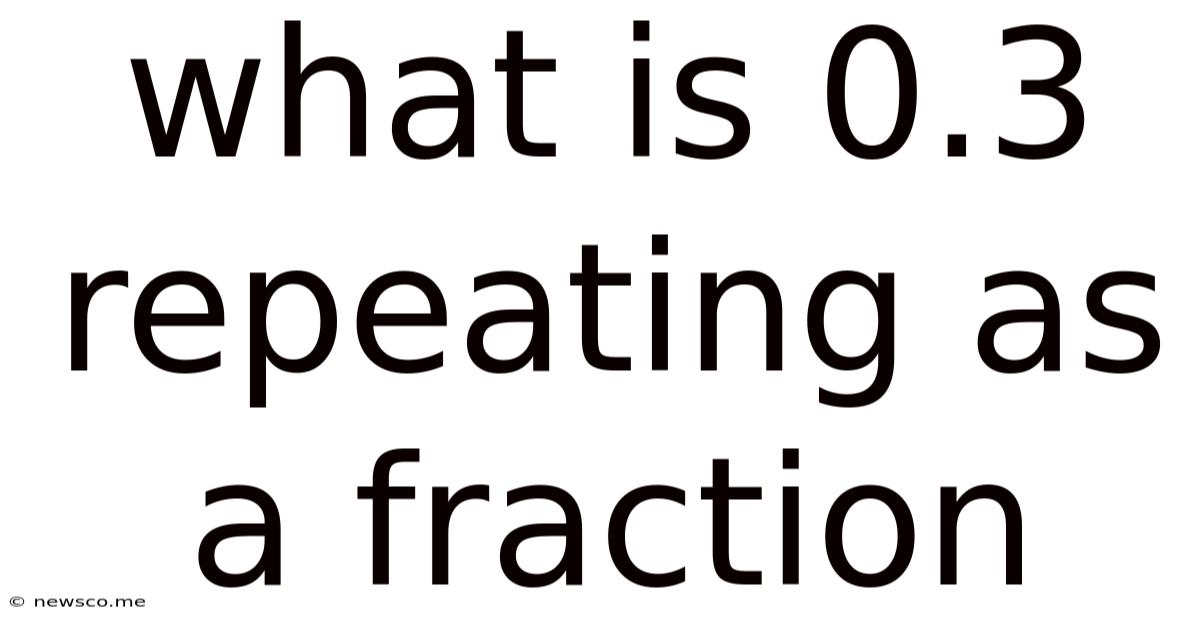What Is 0.3 Repeating As A Fraction
News Co
Mar 20, 2025 · 4 min read

Table of Contents
What is 0.3 Repeating as a Fraction? A Comprehensive Guide
The question "what is 0.3 repeating as a fraction?" might seem simple at first glance, but it delves into the fascinating world of decimal representation and rational numbers. Understanding this concept provides a solid foundation for more advanced mathematical concepts. This comprehensive guide will not only answer the question but also explore the underlying principles and methods used to convert repeating decimals into fractions.
Understanding Repeating Decimals
Before diving into the solution, let's clarify what we mean by "0.3 repeating." This is represented mathematically as 0.3̅ or 0.$\overline{3}$. The bar above the 3 signifies that the digit 3 repeats infinitely. It's not 0.33, or 0.333, or even 0.333333; it's an unending sequence of 3s. This distinction is crucial for accurate conversion to a fraction.
Method 1: Algebraic Manipulation
This method is the most common and widely understood approach for converting repeating decimals into fractions. Let's break it down step-by-step:
1. Assign a Variable: Let's represent the repeating decimal as 'x':
x = 0.3̅
2. Multiply to Shift the Decimal: Multiply both sides of the equation by 10 to shift the repeating part of the decimal:
10x = 3.3̅
3. Subtract the Original Equation: Now, subtract the original equation (x = 0.3̅) from the modified equation (10x = 3.3̅):
10x - x = 3.3̅ - 0.3̅
This simplifies to:
9x = 3
4. Solve for x: Divide both sides by 9 to isolate 'x':
x = 3/9
5. Simplify the Fraction: Reduce the fraction to its simplest form by dividing both the numerator and the denominator by their greatest common divisor (GCD), which is 3:
x = 1/3
Therefore, 0.3̅ is equivalent to the fraction 1/3.
Method 2: Geometric Series
This method utilizes the concept of an infinite geometric series. A geometric series is a series where each term is found by multiplying the previous term by a constant value (the common ratio). In the case of 0.3̅, we can express it as a sum of an infinite geometric series:
0.3̅ = 0.3 + 0.03 + 0.003 + 0.0003 + ...
Here, the first term (a) is 0.3, and the common ratio (r) is 0.1. Since the absolute value of the common ratio is less than 1 (|r| < 1), the infinite geometric series converges to a finite value. The formula for the sum of an infinite geometric series is:
Sum = a / (1 - r)
Substituting our values:
Sum = 0.3 / (1 - 0.1) = 0.3 / 0.9 = 3/9 = 1/3
Again, we arrive at the fraction 1/3.
Verifying the Result
It's always a good practice to verify your answer. To do this, simply perform long division: divide 1 by 3. You'll find that the result is indeed 0.33333... (0.3̅).
Extending the Concept: Other Repeating Decimals
The methods described above can be applied to other repeating decimals. Let's consider a slightly more complex example: 0.12̅.
1. Assign a variable: x = 0.12̅
2. Multiply to shift the decimal: Since the repeating part has two digits, we multiply by 100:
100x = 12.12̅
3. Subtract the original equation:
100x - x = 12.12̅ - 0.12̅
99x = 12
4. Solve for x:
x = 12/99
5. Simplify:
x = 4/33
Therefore, 0.12̅ = 4/33.
Dealing with Repeating Decimals with Non-Repeating Parts
Let's tackle a decimal with both repeating and non-repeating parts, such as 0.23̅.
1. Assign a variable: x = 0.23̅
2. Isolate the repeating part: Rewrite the number as the sum of a non-repeating part and a repeating part. In this case, 0.2 + 0.03̅.
3. Treat the repeating part as a separate problem: We already know that 0.03̅ = 0.03 / (1-0.01) = 1/33
4. Add the non-repeating part: 0.2 + 1/33 = 2/10 + 1/33 = 66/330 + 10/330 = 76/330
5. Simplify: = 38/165
Therefore, 0.23̅ = 38/165. Notice that we simplified at the final stage to get the simplest form.
The Importance of Understanding Repeating Decimals and Fractions
Converting repeating decimals into fractions is not merely an academic exercise. It's a fundamental skill with practical applications in various fields:
- Engineering and Physics: Accurate calculations often require precise representations of numbers, and fractions provide this precision.
- Computer Science: Representing numbers in binary form, used in computer programming, often involves understanding fractional representations.
- Finance: Calculations involving interest rates, discounts, and other financial computations often require fractional precision.
Furthermore, understanding this concept strengthens your overall mathematical reasoning skills and provides a deeper understanding of number systems.
Conclusion
Converting repeating decimals to fractions might initially seem daunting, but with the systematic approaches outlined in this guide – algebraic manipulation and the use of geometric series – the process becomes straightforward. Remember to always verify your answer and to simplify your fraction to its lowest terms. This understanding enhances your mathematical proficiency and opens doors to more advanced mathematical concepts. By mastering this skill, you gain a deeper appreciation for the elegance and interconnectedness of mathematical principles. The seemingly simple question of "what is 0.3 repeating as a fraction?" leads us down a path of exploration and understanding in the fascinating world of numbers.
Latest Posts
Latest Posts
-
Find The Point On The Y Axis Which Is Equidistant From
May 09, 2025
-
Is 3 4 Bigger Than 7 8
May 09, 2025
-
Which Of These Is Not A Prime Number
May 09, 2025
-
What Is 30 Percent Off Of 80 Dollars
May 09, 2025
-
Are Alternate Exterior Angles Always Congruent
May 09, 2025
Related Post
Thank you for visiting our website which covers about What Is 0.3 Repeating As A Fraction . We hope the information provided has been useful to you. Feel free to contact us if you have any questions or need further assistance. See you next time and don't miss to bookmark.